Family : Pinaceae

Text © Eugenio Zanotti

English translation by Mario Beltramini
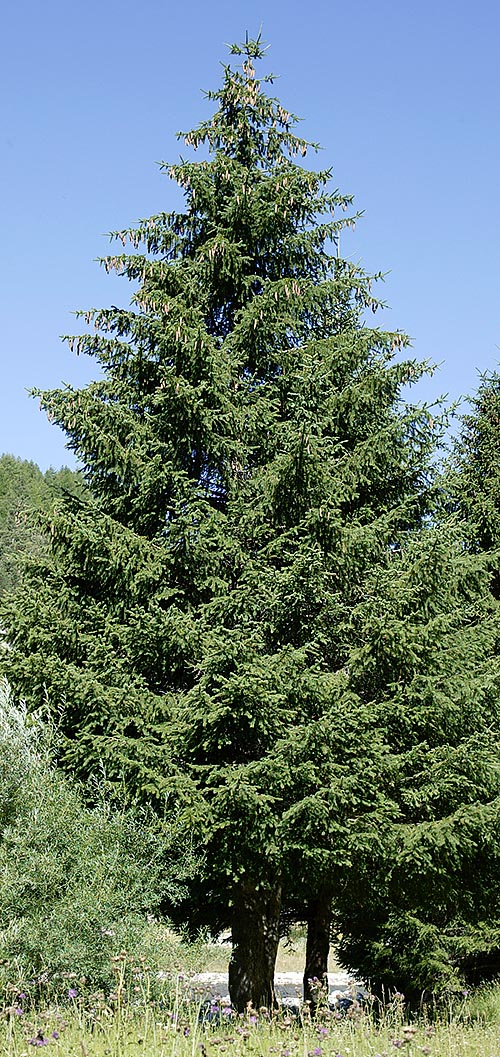
The Norway spruce (Picea abies) lives even 500 years reaching 60 m of height © Mazza
The genus Picea includes, after various authors, 35 to 40 species of trees, all belonging to the Boreal hemisphere.
Some of them occupy a vast northern range, such as Picea abies and Picea obovata in Eurasia; or Picea glauca, Picea mariana and Picea engelmannii in North America. Other species have a more southern and more fragmented distribution, restricted to mountain ranges, such as Picea omorika, native to the mountains of Serbia, Picea orientalis, from the Caucasus and northeastern Turkey, and several species from the Far East (Picea smithiana, Picea asperata, etc.).
The species of the genus Picea are large monoecious trees with small red or yellow male cones, female cones carried higher than the male ones, initially erect, and then pendulous after the fecundation. Sessile strobili ripening in one year and falling entire after the dispersion of the seed.
Some authors have divided this genus into three sections: the first two include the species with needle-like leaves with quadrangular section and with stomatal lines on the four faces: sectn. Abies (including Picea abies and Picea orientalis and some others) and sectn. Casicta with various species, mostly American, like the Picea sitchensis. The entities of the section Omorika are on the contrary identified by flat needle-like leaves (like those of the silver fir), with only two stomatal lines along the lower page. Nevertheless, the subdivision of the genus Picea into these sections, based on some morphological and chemical traits, contradicts the more recent phylogenetic analyses.
The name of the genus comes from the Latin term “pix” = pitch, or resin, for others, the term “picea” is to be referred to a not better identified fir; the name of the species “àbies, abietis” is a classical Latin term (Virgil, ‘Eclogues’), derived, after some authors, for the Sanskrit root “abh” = to gush out (of the resin), or, after others, from the Greek “abios” = since long time, perhaps due to the longevity or the presence of its woods in the territory.
The Norway spruce (Picea abies (L.) H. Karsten 1881) so called because of the colour of the bark, is also known simply as spruce. It is an evergreen arboreal conifer of first magnitude 25-35 m tall as an average but which, in optimal conditions, can reach the 50-60 m of height and trunk circumferences of 2 metres (in exceptional instances, up to 4,8 m). Very long-lived tree, it can live up to 400-500 years, but in the literature there are reports of even much more old specimens!
The stem is slender and for a long trait almost perfectly cylindrical, with dark green top, variable from strictly triangular to more or less strictly ogival. The posture of the branches can be ascending (upper part of the stem), patent (median trait), or pendulous (lower trait).
The radical system is rather superficial and this causes suffering to this species in case of drought; this should lead not to employ this tree, even less if isolated, in the urbanized areas as often is unluckily seen to be done (like with other mountain habitat conifers) in the gardens of the cities of the plain, where, furthermore, is often subjected to drastic pruning interventions (thing it does not tolerate at all..).
The bark is reddish in the young plants and later on becomes grey-brown, desquamating in irregular or roundish plates, 5 mm thick, very rich of resin, in the branches of 1 cm of diameter is brown-reddish, with 1 x 3 mm longitudinal scales ; sub-glabrous year branches, of pale green colour and then reddish. Persistent needle-like leaves up to 8-10 years, with more or less obscurely tetragon-rhomboid section, with four stomatal belts little visible (one per face) slightly prickly, often curved, of 1 (2) x 8-12 (-25) mm, arranged all around the small branches and placed on small relieved “pads”.
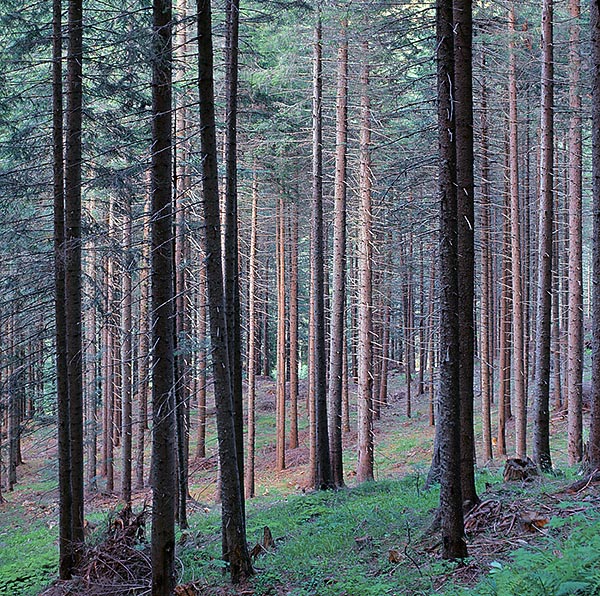
Red bark and light wood used in making musical instruments and in paper industry © Giuseppe Mazza
Strobili (cones) are pendulous when ripe, sub-cylindrical, and pointed at the apex and often somewhat curved, of 3-4 x 8-15 cm, and can be green-yellowish (variety chlorocarpa) or reddish (variety erythrocarpa); are carried in upper third of the top and at the apex of the small branches of the previous year.
The fecundation takes place, depending on the altitudes and the climate, from April to June. The seeds (each scale protects two of them) are brown, (2) 3-5 (4) mm long, with a face much more convex than the other, surrounded by a semi-transparent wing, up to 16 mm long, glossy and thin.
Traditionally, in many countries the Norway spruce is the classical Christmas tree, to adorn for the most loved festivity; many nurserymen cultivate specimens in pot or in the ground for such use.
The wood, called also “wood of Moscovia” is whitish or yellowish tending to turn darker towards the reddish with the age, without apparent duramen, presents well visible rings, regular and evident resiniferous vessels; has slight resinous smell, of medium texture and straight grain, rather light (mass vol. 450 kg/mc), tender and slightly glossy. It is vastly employed, in addition to being an excellent fuel with high calorific power, for current works of joinery, furniture cases, matchboards, for fixtures and packaging, and is appreciated because, once dried, stabilized and treated, is very little attacked by the insects and fungi and maintains the shape; appreciated also in the paper industry as well as in the making of musical instruments, seen the excellent properties of amplification, especially for the soundboards of guitars, mandolins, violins, harpsichords, pianos, etc. Famous are the “resonance firs” of the Fiemme Valley and also of the Paneveggio forest, in Trentino and that of the Canal Valley and of the Tarvisano, in the province of Udine, of Croatian woods, etc., appreciated and utilized since centuries and still now used for the same purpose by famous firms building concert pianos such as Bechstein, Blüthner and Fazioli.
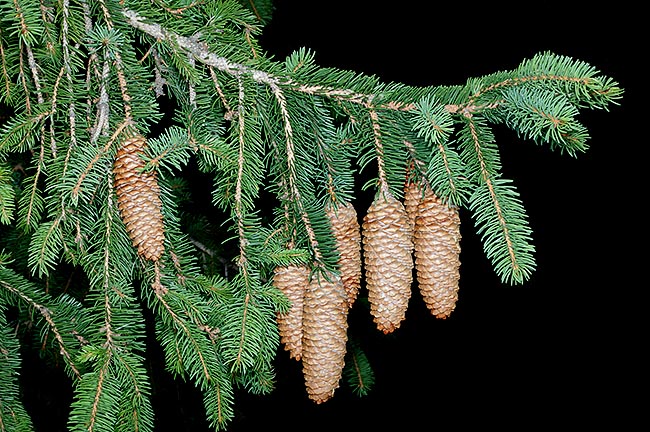
It easily distinguishes from the silver fir (Abies alba) because the cones look down © Giuseppe Mazza
Due to the particular facility in slitting, it was much utilized for making boxes (for cheeses), clapboards and shutters for windows, etc. A curiosity: the first plane of the Wright brothers was made with the wood of this tree. The Norway spruce loves the continental climates, is a micro-thermal species (bears lowest temperatures up to -36 °C!), heliophilous and mesophilic, is the main member of the sub-Alpine forest of coniferous, of major importance for the Alpine forestry and therefore amply cultivated and diffused by the man also in the areas naturally favourable to the beech, in central-northern Europe up to the plainland altitudes.
The spruce forest, or the “Piceetum subalpinum” (Taiga) forms of acidic podzolic soil, therefore usually on crystalline rock, rarely calcareous, from the plain up to 2200 m of altitude. Along with the subspecies obovata (recently raised to the rank of new species: Picea obovata Ledeb (2005), which populates the Siberian forests) is the most important woody species in the world, thanks to the vastness of its range and the density of the populations, for the use of the timber. Its range includes the whole Siberia up to the Pacific, the plains of Poland, of Russia and the plains and hills of the Scandinavian countries, the mountains of Europe up to the Alps, on which it stands between the 800 and the 2200 metres of altitude. In Middle Europe is diffused for wood zones of various millions of hectares done on hills and plains lands originally occupied by the oak forests. Until a few decades ago, the forestall utilizations were cyclical, with clearcuttings on vast surfaces that, when recovering, formed coetaneous and uniform woods; presently are preferred utilizations distributed in the time leading to non-coetaneous woods, ecologically more balanced.
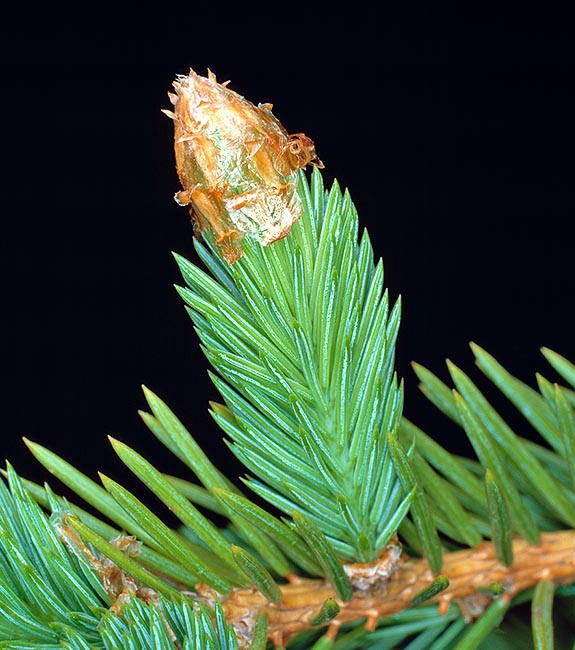
The leaves are needle-like, with quadrangular section, and stomatal lines on the four faces © Mazza
So, the Norway spruce can be considered, amongst the trees, as the king of the Alps; the forests of spruce, humid and full of resinous and fungal odours in the valleys looking north.
The great Valerio Gacomini did write:
“The temperate solemnity of the Alpine forests enters landscapes of unequalled majesty, created by the magnificence of the granitic and dolomitic mountains, by the splendour of the permanent snows and of the glaciers, by the emerald basins of lakes, by the morbid stretches of grasslands. Extraordinary and contrasting harmonies settle between the sky, the land and the waters mainly where they advance towards the highest rocks, towards the vast altitude plains, the last troops of this highly productive vegetation, that challenges frosts and lightning”.
From the phytosociological point of view, the spruce woods are usually classifiable in the class Vaccinio-Piceetea; the woods of the mountain belt on the siliciferous substrata, where due to the acidification of the soil and the scarce presence of light the under-wood is rather poor, has also some small shrub like the Bilberry (Vaccinium myrtillus) and the Lingonberry (Vaccinium vitis-idaea), not to forget other well known herbaceous species such as the Oxalis acetosella, the Maianthemum bifolium, Solidago virgaurea, Homogyne alpina, Hieracium sylvaticum, Calamagrostis villosa and the ferns Athyrium filix-femina, Dryopteris filix-mas, Cystopteris fragilis.
The sub-Alpine spruce wood, with same substratum, hosts also Sorbus aucuparia, Lonicera nigra, Lycopodium annotinum, etc., and a rich layer of mosses.
Up to about the 1500 m of altitude, the Norway spruce is at times in competition with the Silver fir (Abies alba). In the most open and luminous locations, at the upper limits of the wood, it may meet the European larch (Larix decidua) and the Swiss pine (Pinus cembra), known also as Arolla pine, and is often mixed with the bushes of Rusty-leaved alpenrose (Rhododendron ferrugineum), Common juniper (Juniperus communis) and the Alpine rose (Rosa pendulina). Numerous are the species of fungi living in the spruce wood, the most celebrated among them are the Ceps (Boletus edulis and Boletus pinophilus), living symbiotic with the Norway spruce, as well as the Spotted milkcap mushroom (Lactarius scrobiculatus).
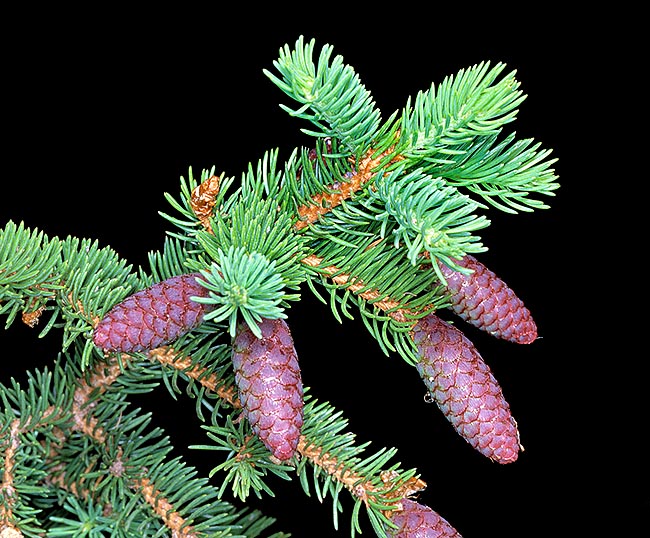
Young cones carried in the upper third of the top, at the apex of previous year small branches © Giuseppe Mazza
Also the avifauna is rich and very specialized: we recall here the Common crossbill (Loxia curvirostra) with its crossed beak, adaptation allowing him to easily extract the seeds of the cones. The Siskin (Spinus spinus) during the breeding season, also eats the seeds it extracts with its sharp beak, from half open cones. The Coal tit (Periparus ater), the Crested tit (Lophophanes cristatus), the Willow tit (Poecile montanus) and the Marsh tit (Poecile palustris), the Common treecreeper (Cerchia familiaris), some woodpeckers and the Goldcrest (Regulus regulus) are formidable hunters of insects and consequently friends of the trees of the wood.
Then there are small and big mammals, as well as the precious Red wood ants (Formica rufa) who build with the needles huge pyramidal nests, species rightly protected in several European countries due to its utility in contrasting the proliferation of the insects dangerous for the conifers.
Besides the natural or artificial diffusion by seed, the Norway spruce can propagate also by offshoots when the lowest branches are constantly in contact with the soil and when they emit roots; this happens with a certain frequency in high mountain, where the weight of the snow obliges the branches to bend down to the ground, almost to help – in scarcity of production of seeds due to the limit conditions – the specimens most “daring” to produce vigorous progeny. Unfortunately many are the adversities hitting the spruce woods caused by insects like the scolytids (Ips typhographus, Cryphalis piceae), curculionids of the genus Pissodes , hymenopterans (Cephalcia arvensis), lepidopterans (Epinotia tedella), aphids, etc., besides white rot fungi such as the Heterobasidion annosum .
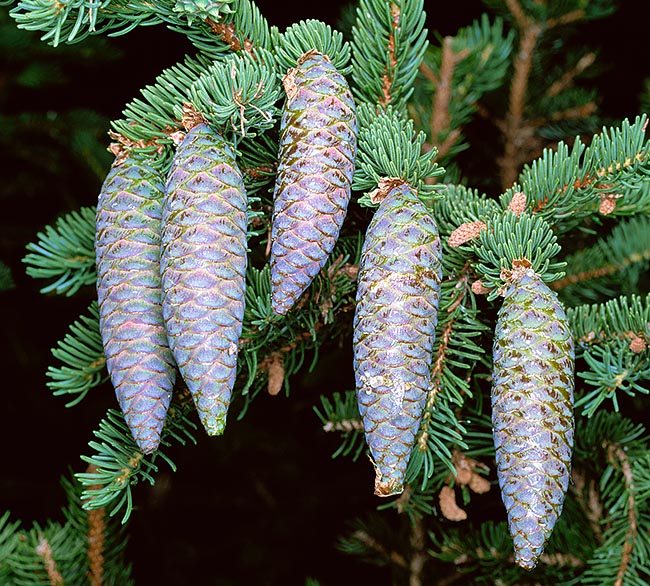
The subcylindrical cones, pointed at the apex, can reach 15 cm. Greenish or reddish, turn brown when ripe, before falling on the ground, with the scales raised, to disperse the seeds © Giuseppe Mazza
From the honeydew produced by the aphids on the small branches of the Norway spruce, the bees get a very dark honey, almost blackish, considered as an excellent antiseptic of the respiratory tract, with expectorant and vermifuge power.
The resin getting down from the incisions done on the bark of the trunk and the branches (resin extraction) forms the so-called Burgundy pitch (Pix Burgundica F.I.). From its distillation they get the “Strasbourg” turpentine (or vegetal turpentine). The Italian pharmacopoeia (1929) registers the white pitch or Burgundy pitch (Pix burgundica): a solid substance, almost opaque, with smell and taste of turpentine; it is gotten from the trunk and the big branches of the Norway spruce… It was used, along with wax and nutmeg oil, for the preparation of rubefacient and stimulating adhesive poultice used in the past against the severe migraines and the rheumatic pains. In phytotherapy, they employ the extracts of needles (Extractum pini) taken from the young fresh branches; the essential oil of needles (Oleum Piceae foliorum) and the young buds.
The essential oil contains terpinene, pinene, camphene, phellandrene, and bornile acetate, the glucoside picein, pinepicrin, flofaben, resins, tannin and one ethereal oil that confer antiseptic, balsamic, expectorant, sedative, antiseptic, antphlogisitc, etc. properties. It is used for frictions in the diseases of the respiratory system, in the rheumatisms and in the muscular pains and enters the composition of the inner spaces deodorants. The needles, their extracts and the wood of the Norway spruce are used for preparing beneficial baths (with natural extract, tannic bath and bath of wood); stimulant and reinvigorating.
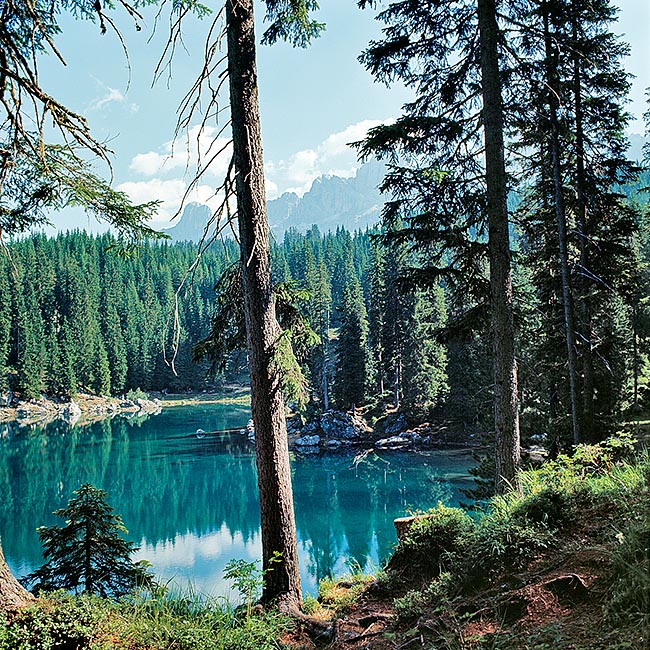
The Norway spruce creates dark, cold, humid forests, full of resinous and fungal odours in the looking north forests © Giuseppe Mazza
The buds must be hand picked, from February, before they begin opening, whilst the young small branches with the leaves can be collected during the whole year, preferably from at least 60-80 years old specimens (richer of essential oil). He who frequents the mountains or knows some park or garden far away from the trafficked roads or polluted environments, can gather every year small pieces of bark of Norway spruce before winter to utilize for beneficial fumigations in the respiratory apparatus ailments or put one in every water container of the radiators for perfuming beneficially the house.
Preparations:
Skin stimulating and depurative bath
Put in a non-iron skillet three handfuls of needles in three litres of cold water, bring to a boil, turn off the heat and wait until the preparation is lukewarm, strain for eliminating the exhausted needles and add to the warm water already ready of the bath tub, staying there for half an hour.
Decoction of buds for the bronchitis and the flu colds
One teaspoon of dried buds, or two of fresh buds, to be boiled 3-4 minutes in a cup of water. To drink half in the morning and half in the evening sweetening with honey.
Synonyms: Pinus abies L. (1753); Abies picea Mill. (1768); Pinus viminalis Alstr. (1777); Pinus sativa Lam. (1779); Pinus excelsa Lam. (1779); Abies cinerea Borkh. (1800); Abies excelsa (Lam.) Poir. (1804); Abies minuta Poir. (1804); Picea rubra A. Dietr. (1824); Abies viminalis Wahlenb. (1826); Picea vulgaris Link (1827); Abies clanbrassiliana P. Lawson (1836); Abies commutata var. mucronata (1841); Picea excelsa (Lam.) Link (1842); Pinus picea var. carpatica (Loudon) Endl. (1847); Abies elegans Sm. ex J. Knight (1850); Abies parvula Knight (1850); Abies vulgaris var. nana Wender. (1851); Picea montana Schur (1851); Picea subarctica Schur (1853); Abies lemoniana Booth ex Gordon (1858); Abies finedonensis Gordon (1862); Abies gregoryana H. Low. ex Gordon (1862); Abies inverta R. Sm. ex Gordon (1862); Abies montana Nyman (1865); Abies extrema Th.Fr. (1867); Abies gigantea Sm. ex Carrière (1867); Abies carpatica (Loudon) Ravenscr. (1868); Abies medioxima C. Lawson (1868); Abies coerulescens K. Koch (1873); Abies eremita K. Koch (1873); Abies clambrasiliana Lavallée (1877); Abies conica Lavallée (1877); Abies erythrocarpa (Purk.) Nyman (1881) ; Abies subarctica (Schur) Nyman (1881); Picea abies (L.) H. Karst. (1881); Abies alpestris Brügger (1886); Picea alpestris (Brügger) Stein (1887); Picea cranstonii Beissn. (1891); Picea excelsa var. alpestris (Brügger) Beissn. (1891); Picea finedonensis Beissn. (1891); Picea gregoryana Beissn. (1891); Picea maxwellii Beissn. (1891); Picea obovata var. alpestris (Brügger) A. Henry (1891); Picea viminalis (Alstr.) Beissn. (1891); Picea velebitica Simonk. ex Kümmerle (1916); Picea abies (L.) H.Karst. f. argentea Rehder (1923); Picea abies f. columnaris (Jacques) Rehder (1923); Picea abies f. cupressina (F. Thomas) Rehder (1923); Picea abies f. erythrocarpa (Purk.) Rehder (1923); Picea abies (L.) H.Karst. f. mucronata (Loudon) Rehder (1923); Picea abies f. parsonsii (Hornibr.) Rehder (1923); Picea abies f. veitchii (Hornibr.) Rehder (1923); Picea integrisquamis (Carrière) Chiov. (1935); Picea abies var. arctica Lindq. (1948); Picea abies subsp. europaea (Tepl.) Hyl. (1953); Picea abies subsp. obovata (Ledebour) A.E.Murray (1982); Picea abies var. alpestris (Brügger); P.A.Schmidt (1988); Picea abies f. alpestris (Breugg.) Krussmann. (1971); Picea abies subsp. acuminata (Beck) Parfenov (1971); Picea abies subsp. alpestris (Stein) Parfenov (1971); Picea abies f. deflexa (Tvszkiewicz) Krussmann. (1971); Picea abies subsp. fennica (Regel) Parfenov (1971); Picea abies (L.) H.Karst. f. integrisquamis (Carrière) P.A.Schmidt (1987); Picea abies (L.) H.Karst. subsp. acuminata (Beck) Silba (2008).
→ To appreciate the biodiversity within the PINACEAE family please click here.
